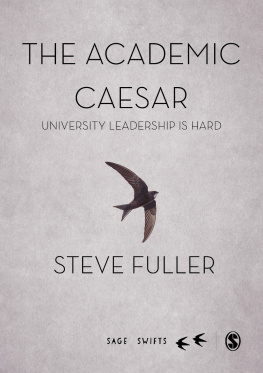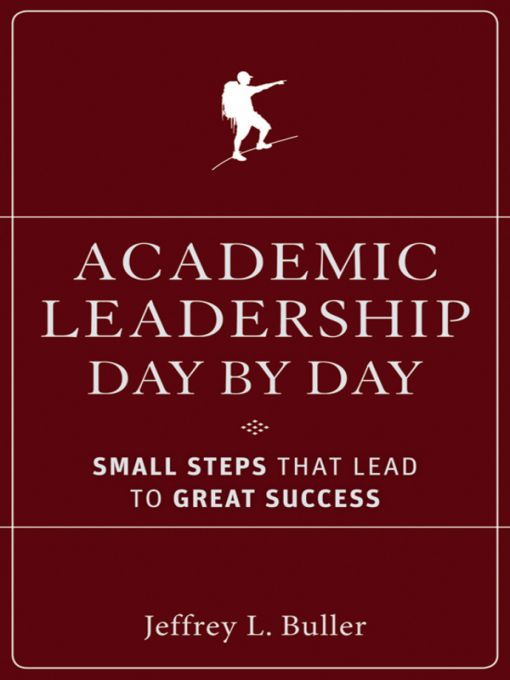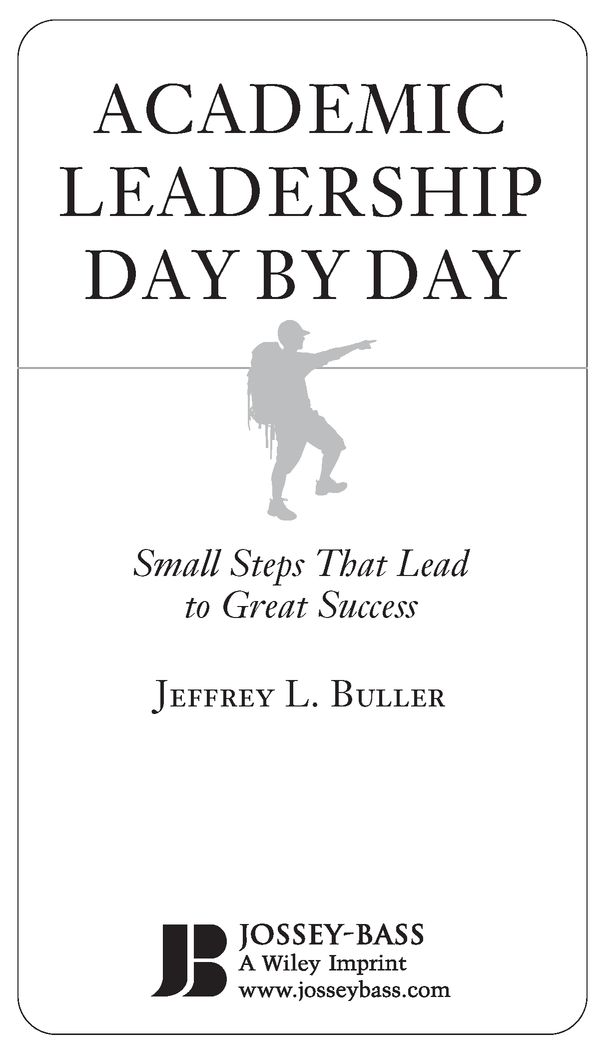Table of Contents
OTHER BOOKS BY JEFFREY L. BULLER
The Essential Department Chair: A Practical Guide to College Administration
The Essential Academic Dean: A Practical Guide to College Leadership
The Essential College Professor: A Practical Guide to an Academic Career
Classically Romantic: Classical Form and Meaning in Wagners Ring
Preface
Whenever I speak to leaders in higher education, they inevitably ask for ideas about how to handle the heavy workload of their jobs and manage their time better. Theyre always interested in learning ways to improve their academic leadership and become more effective; they just dont know when theyd ever find the time to read a book about academic leadership or to fit new approaches into their already overcrowded days. I have written Academic Leadership Day by Day with precisely this type of administrator in mind. The entries in this short guide have been created for several audiences:

For academic leaders at all levels, from department chair and program director through chancellor and chief executive officer, I wanted to create an administrative equivalent to all those familiar books with titles like Daily Thoughts for Daily Improvement or An Idea a Day to Streamline Your Life. I must admit that Im hopelessly addicted to books of this sort. I love the notion of taking a suggestion, boiling it down to its simplest form, and presenting it in a way that makes it useful to even the busiest people in only a few minutes each day.
For administrators who believe that they need to turn their institutions upside down with continual change and the implementation of one grandiose strategy after another, Id like to offer a rebuttal. If a school or program is facing a major disastereconomic collapse, severe enrollment decline, a scandal that landed it on the front page of the Chronicle of Higher Education, or something similarthen, by all means, go ahead and initiate a radical change, because channeling everyones energy into a brand-new initiative is probably necessary. But not every problem is a crisis. As my friend Don Chu likes to say, not every problem is really a problem. For institutions that have been reasonably successful and just want to get better, diverting peoples attention from their core tasks of teaching, scholarship, and service to focus on strategic visioning, repositioning, and inculcating a culture of continual, significant change is at the very least unnecessary. Even worse, the sense that everything about an institution must be constantly turned upside down can end up being highly destructive. There are plenty of little things that each of us can do to become better administrators, more effectively serve the needs of our stakeholders, increase our own job satisfaction, and improve the overall success of our institutions. In fact, some of the best administrators Ive known werent those who spent their days trying to implement big ideas. They were the ones who got the little details right and realized that small steps lead to great successes. In fact, you might say that the theme of this book is that if you take full advantage of each little moment that comes your way as an academic leader, the big issues will largely take care of themselves. Increasingly Ive learned that small improvements are the best way to tackle big issues; sometimes theyre the only way. To those who trot out the old objection that you cant cross a twelve-foot canyon in two six-foot jumps, Id reply, Of course. I couldnt agree with you more. But how many times in your travels have you ever really had to cross a twelve-foot canyon?
For readers who regard the typical book about academic administration as an invasive species that has somehow been transplanted from the world of business to the world of higher education, Id like to provide a resource thats practical because it relates to what academic leaders really do. The suggestions in this book are all drawn from my own experience as a department chair, dean, and vice president for academic affairs, as well as dozens of workshops that Ive conducted for university administrators all over the world. Im certain that every reader will find some of the entries in this book more useful than others, but Im equally sure that each persons list of the suggestions that really mattered to him or her will be different. For this reason, Ive avoided offering ideas that may sound impressive but are ultimately impractical (the bane of most management books) and have tried to fill each day with advice that works.
For those who know someone who has recently been appointed to an administrative position, this book would be a useful gift. You can include Academic Leadership Day by Day with a card of congratulations (or perhaps a sympathy card) inscribed, Youre going to need this! I wish Id received a book of this sort when my dean told me that I was going to be my departments next chaireffective immediately. I had no idea what my new job entailed. Every other member of my department was only a year or two from retirement, and I was the youngest member of the faculty. My teaching load at that time included at least four courses every semester, not to mention scholarship I needed to complete if I ever wanted to be considered for promotion and tenure. I simply didnt have time to read a library of books on academic leadership and decide which of them was useful. A guide that gave me one good idea a day wouldve been perfect, so Ive finally gotten around to creating one. I hope it finds its way to all brand-new university chairs, not to mention deans, provosts, and presidents.
For faculty members or academic leaders who hope to attain a higher position in administration within a year or two, I wanted to write a book that would help you prepare for the application process and interviews. Youll find in these daily entries a year-long coaching session that will help you prepare for the types of questions youre likely to be asked and for the level of experience youll be expected to have. If you follow the suggestions I have outlined in this guide, youll be a better administrator at the same time that you amass the sort of expertise in budgetary management, program review, institutional advancement, and other activities that todays administrators today are expected to master. You can think of this book as your daily administrative horoscope. But rather than offering you only vague suggestions about things that may possibly occur in your personal life, Academic Leadership Day by Day will guide you to small but significant steps toward greater administrative effectiveness. You may already have considered many of these suggestions on your own, and several of the others may strike you as extremely easy, perhaps even somewhat trivial. But in order to keep each days activity manageable within the schedule of an active administrator, Ive focused on the small tasks we know we ought to be doing rather than the extravagant plans well probably never fulfill. My goal is to give you that extra voice of encouragement youll sometimes need to take even a slight step toward making a big improvement in your program and perhaps also open the door to an exciting career opportunity in the future.











